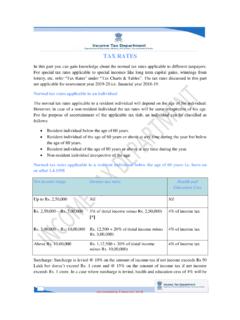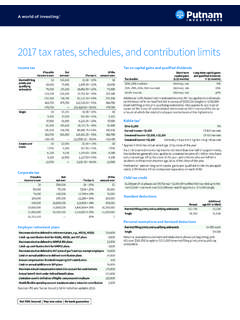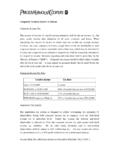Transcription of TAX ASPECTS OF CORPORATE MERGERS AND …
1 TAX ASPECTS OF CORPORATE MERGERS AND ACQUISITIONS William F. Griffin, Jr. Davis Malm & D Agostine, , Boston The following outline is intended to acquaint the reader with some of the more important income tax ASPECTS of merger and acquisition transactions among corporations. As with any summary, most of the general statements which follow are subject to numerous exceptions and qualifications. For example, the tax consequences of a transaction may vary significantly if one or more of the parties is a member of a consolidated group, an S corporation, a foreign corporation, or a tax-exempt organization.
2 You should rely on a more comprehensive treatise for complete and detailed information on this subject. See generally, Ginsburg, Levin & Rocap, MERGERS , Acquisitions, and Buyouts (2014); Bittker & Eustice, Federal Income Taxation of Corporations and Shareholders ( Seventh ed. 2014); Freund, Anatomy of a Merger (1975); Phillips, 770-4th , Structuring CORPORATE Acquisitions - Tax ASPECTS (2014); Kling & Nugent-Simon, Negotiated Acquisitions of Companies, Subsidiaries and Divisions (2013); Eustice & Kuntz, Federal Income Taxation of S Corporations (Fourth ed. 2014). I. CLASSIFICATION AND TAXATION OF BUSINESS CORPORATIONS For Federal income tax purposes, business corporations can be classified either as "S corporations" (those qualifying corporations electing favorable tax treatment under Subchapter S of the Internal Revenue Code) or "C corporations" (all others).
3 C Corporations C corporations are subject to a Federal income tax at graduated rates with a maximum effective rate of 35 percent for 2015. Since a C corporation's shareholders are also taxed on the distribution of CORPORATE earnings in the form of dividends, C corporation income is subject to "double taxation," first at the CORPORATE level, and again at the shareholder level. For this reason, many corporations elect to be taxed as S corporations, which, very generally speaking, are treated as "passthrough" entities similar to partnerships. C corporations doing business in Massachusetts are subject to the Massachusetts corporation excise tax under Chapter 63.
4 This tax consists of two components: an tax on CORPORATE net income attributable to Massachusetts, plus a tax equal to $ per $1,000 of tangible property not subject to local taxation and situated in Massachusetts. A minimum tax of $456 per year is imposed. 2 S Corporations Under IRC 1361, a corporation must meet certain tests in order to qualify for S corporation status: it must have 100 or fewer shareholders (a husband and wife are treated as one shareholder); all stockholders must be individuals (or certain permitted trusts, estates tax-exempt organizations); no shareholder may be a non-resident alien; and the corporation may have only one class of stock (differences in voting rights are permissible).
5 In order to secure the benefits of S corporation status, an election on Form 2553 must be filed with the Internal Revenue Service. Note that Form 2553 must be signed by all shareholders of the corporation, a requirement which is sometimes overlooked. An S corporation, in general, must adopt a calendar year as its taxable year. Its first fiscal year is considered to start on the date on which the corporation (a) has shareholders, (b) acquires assets, or (c) begins doing business, whichever is earliest. An S corporation election must be filed on or before the 15th day of the third month of its tax year.
6 Upon failure on the part of an S corporation to comply with all of the conditions of eligibility, its election is automatically terminated. IRC 1362(d)(2). The IRS has the authority to waive inadvertent terminations which are timely corrected. IRC 1362(f). An S election may be revoked by shareholders owning 50% of the outstanding shares (voting and nonvoting) of the S corporation. IRC 1362(d)(1). Once an S election is terminated or revoked, the corporation may not reelect S corporation status for five years. IRC 1362(g). S corporation income is subject to a single tax at the shareholder level, with a few exceptions for former C corporations which distribute C corporation earnings and profits.
7 C corporations that elect S corporation status are taxed on the CORPORATE level on any so-called built-in gains on the taxable disposition of appreciated assets during the ten year period beginning on the first day of the S corporation s first taxable year. IRC 1374. C corporations with accumulated earnings and profits that elect S corporation status may also be subject to tax on the CORPORATE level on their excess net passive income following the election. IRC 1362(d)(3). An S corporation may own stock in a C corporation. However, an S corporation may not own stock in another S corporation, because the subsidiary s stock would be owned by a corporation, and a corporation is an ineligible S corporation shareholder.
8 This would terminate the subsidiary s S corporation election under IRC 1362(d). An S corporation may, however, elect to treat a 100% owned domestic corporation as a qualified S corporation subsidiary 3 ( QSub ) under IRC 1361(b)(3). A QSub is treated as a disregarded entity and not a separate corporation for tax purposes, and all of its assets, liabilities, income, loss, and tax credits are deemed to be owned by its S corporation parent. IRC 1361(b)(3)(A). Under Massachusetts law, "big" S corporations are subject to tax on their 2015 net income at a percent rate if their total gross receipts are equal or exceed $6 million, and percent if total gross receipts equal or exceed $9 million (this tax rate is computed by a statutory formula and thus may vary from year to year).
9 C. 63, 32D. S corporations must also pay the $ per $1,000 tangible property component of the corporation excise tax. The $456 minimum tax is also imposed on S corporations. II. ACQUISITIONS INVOLVING C CORPORATIONS This Section deals with the tax consequences of acquisitions and MERGERS where all parties to the transaction are C corporations. Section III deals with acquisitions and MERGERS where one or more parties to the transaction are S corporations. As a matter of terminology, the parties to the transactions described in this Section are identified as follows: P means the purchasing or acquiring corporation; S means a wholly-owned CORPORATE subsidiary of P; and T means the acquired corporation, or target.
10 Taxable Purchase Of Stock In this transaction, P purchases all of T s stock directly from T s shareholders, in consideration of cash, notes, or some other taxable consideration (or a combination thereof). As a result, T becomes a wholly-owned subsidiary of P. (a) T s shareholders recognize gain or loss on the sale of their stock, usually capital gain or loss, measured by the difference between the basis in the stock and the purchase price. Generally, individuals are taxed at a maximum rate of 20% on capital gains under current Federal income tax law. (b) T recognizes no gain or loss on the transaction and its tax basis in its assets remains unchanged.








